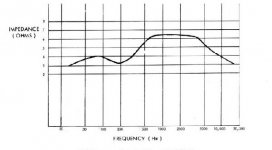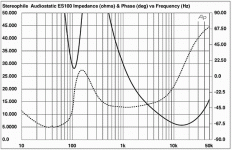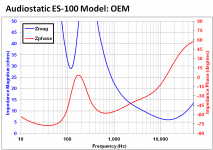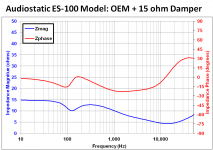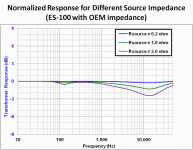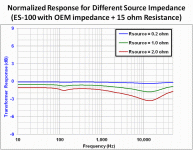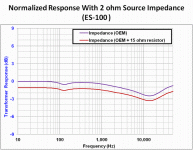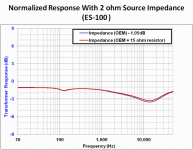If that works for you, no problem.No, this applies over the whole audible bandwidth.
Constant directivity is not needed and can't be achieved fully in praxis.
Exactly. And when a single instrument is broken up into two completely different patterns, then - don't know about you - I can hear it.What's important is that the shape of the directivity pattern remains smooth, without sharp breaks over the frequency band.
Maths? I report what I hear. I couldn't care less what I read when listening to a recording of a piano.If You don't believe it, believe in maths .... and read Baxandall.
When it is consistent and frequency invariable, I would agree. I would place my Acoustat 1+1s in that category. So long as you're on axis, you get a realistic image. They beam consistently. Just don't move your head. Or expect to have a good listening area for more than one.
When part of the frequency range beams, however, and the rest doesn't, I can certainly hear the difference. Now you've got fun house mirror time in terms of the apparent soundstage.
I'm not sure you get my point. Perhaps if I said, "Only from the point of view of the driver is it a funhouse mirror, but from the point of view of the listener, not so."
Ben
Ben, I think I understand you quite clearly. We just disagree.I'm not sure you get my point. Perhaps if I said, "Only from the point of view of the driver is it a funhouse mirror, but from the point of view of the listener, not so."
A funhouse mirror doesn't care that it distorts the visual image from the perspective of the viewer. Similarly, a driver doesn't care that its disparate polar response from its neighbor creates an audible discontinuity from the perspective of the listener. Especially where they meet.
My ear and brain, however, do care. If yours do not, count yourself lucky.
The room dimensions are 26'x15' with some odd extensions at front and rear from the dormers. Panels are about eight feet out in the room and listening distance is about another 8 feet. Roughly thirds of room. I measured using Stereophile Test CD and Radio Shack SPL meter with adjustment tables.I am geting old......but to get a flat 30 hz...not talking about 6-10db down...you would have to be over 50'away.
I've heard lower bass at Sea Cliff albeit using large Nola Grand Exoticas or Scaena 1.4s each using multiple large subs. HP's room is a bit longer than mine, but not nearly 50'.
Would I be correct in assuming the change to lower frequency blending is related to the experiments with ER Audio’s transformer documented here?The current backplates use a completely different low frequency transformer blended at a lower frequency with more uniform impedance.
Au Transformer Paper
Aaaah, ok the weak motor comment makes sense. It is unrelated to the diaphragm thickness you had mentioned. The weak motor results from the unusually large D/S spacing chosen to allow the desired diaphragm motion at low frequencies. The required/permissible bias voltage increases linearly with D/S spacing both of which are about 3x larger on the SL than Acoustats, no SF6 required. To keep the same motor strength you would need to scale up the stator voltages(ie step-up ratio) proportional to the D/S spacing as well. The SL step-up ratios are actually similar to the Acoustats not 3x higher, hence the weaker motor. However, the larger panel area compensates for this resulting in overall sensitivity being on par with many other ESLs. It’s all about design choices and trade-offs.Perhaps I have confused what I've heard Dr. West say, but the "motor" of his electrostats is relatively weak as compared to others due to its design. Other than the former D-W design immersed in SF6, I don't know of any other than runs as high a bias voltage.
I would certainly be interested to see some imedance curves of the latest SL interfaces, if you have them.The basis is comparing measured curves. I'm out of town and don't have access to them, but they do not look like a roller coaster. The Acoustat is actually pretty uniform, albeit very low. The Sound Lab has relatively high impedance at the bottom but gradually falls, levels out for a while then falls again at the top octave. Neither is as "spikey" in appearance.
BTW, I am not saying that dual transformer ESLs like the SL or Acoustat can’t have flatish impedance curves. What I am saying is that using two transformers does not produce a flat impedance curve by itself. In fact it often results in two peaks in the impedance curve rather than just one. It is the other crossover parts used with the transformers that define the impedance curves. In particular, damping resistances used in the SL and Acoustat crossovers to facilitate the response mixing are what flatten the peaks. If interested, I can send you a SPICE model for a two transformer ESL interface where you can readily see the affect of crossover design on the overall impedance.
If an ESL designer using a single transformer wanted to flatten the impedance curve it is a simple matter of adding some conjugate load circuits are shunt resistive damping. A second transformer is not needed. FWIW, I often use a 15 - 30ohm shunt resistor to effectively flatten the impedance curve along with a small amount of inductance to keep the phase of the impedance < 30deg at higher frequencies where some amplifiers have stability issues.
The primary reasons to use dual transformers for a FR ESL are increased power handling capability at full audio bandwidth and EQ of dipole roll off.
In the room those particular A-1s were set up in, the bass control needed to be at +3dB to get the bottom octaves up to the same level as the midrange. I think it may have been the high ceilings. The mid control needed to be at +3dB as well otherwise there was a noticeable depression in the midbass. It is my understanding that the newer HF transformer fills in this midbass area without the low impedance side effect. Personally, I thought it was great that enough flexibility was provided to get balanced sound in a variety of rooms. The down side is that the partnering amplifier needs to be up for the task. Perhaps line-level controls between pre and power amp would be better?I'm not sure why anyone would choose either setting. I've never run midrange at anything other than flat and find that the most linear response at the bottom in my room typically comes with the bass control at -3.
I think this disagreement is similar to the dual transformer discussion, where claims for technical features don’t lead directly to the conclusion.Maths? I report what I hear. I couldn't care less what I read when listening to a recording of a piano.
I dont' think Calvin is saying a 90deg arc can’t sound good. What he is saying is your comment that:
“The Sound Lab U-1s have uniform directivity across a 90 degree arc (via the multiple facets) in the top seven or eight octaves ...”
…is acoustically inaccurate. Once the wavelength of sound gets on the same order of magnitude as the dimension of the arc the sound waves stops being directed by the curved geometry. It isn’t exactly up for debate. Most likely the transition to dipole figure 8 radiation pattern lower down in frequency is smooth, but the directivity won't be uniform over seven octaves. Perhaps controlled directivity would be a better description.
Your assessment of the SL qualities from listening to music are perfectly valid.
However, assigning technical reasons for these qualities are nearly always more complicated than the technical features mentioned in the manual/brochure.
Last edited:
Yes.Would I be correct in assuming the change to lower frequency blending is related to the experiments with ER Audio’s transformer documented here?
Fair statement.It’s all about design choices and trade-offs.
I'm more of a listener than a numbers watcher. The new toroids mate better with my tube amps.If interested, I can send you a SPICE model for a two transformer ESL interface where you can readily see the affect of crossover design on the overall impedance.
I'd say that is a notable objective.The primary reasons to use dual transformers for a FR ESL are increased power handling capability at full audio bandwidth and EQ of dipole roll off.
Your guess is as good as mine. I don't find the need to vary the midrange control.Perhaps line-level controls between pre and power amp would be better?
Call it what you please. I don't like hybrid stats with tweeter sections whose polar response is decidedly narrower from what is radiated below. The illusion suffers.Perhaps controlled directivity would be a better description.
That's been my position for forty five years or so.Your assessment of the SL qualities from listening to music are perfectly valid.
As I observed earlier, marketing claims often make their way into product literature. On the other hand, I have never heard a more coherent, neutral sounding and wide band electrostat than a Sound Lab. Dual 945s or U-1/U-1bs would work quite nicely, thank you very much.However, assigning technical reasons for these qualities are nearly always more complicated than the technical features mentioned in the manual/brochure.
If people think that a quad esl is boring i think they don't know how live music sounds. And i mean live, non amplified music! Or the have really bad equipement....
Hi,
Audible performance of ESLs is the prominent parameter on a personal level only
On the technical side better performance is directly related to the panels efficiency.
And guess what ... audible and technical performance coincide.
Most obvious are the differences in dynamic performance and lively 'dynamic' sound impression.
The lower the panel's inherent efficiency, the more lame and boring it sounds, the Quads beeing the prime example.
And a ESL uncapable to reproduce a fff peak realistically, or loud Rock music or Techno, etc. is imho sonically restricted.
Why should one choose for 200W that do quite well, when You can do with 20W really well?
jauu
Calvin
Last edited:
I think Quads are dull and I listen to lots of serious music live.
But I think many audiophiles play music louder at home than at concert halls (where the music loudness would rarely interfere with a whisper to a neighbour, if you were so inclined).
I wonder why they seem dull to me? Limited dynamic range which means they squelch micro-peaks in the sound? Nicely balanced sound... weak lows and weak highs? Some systems constantly remind you of their bass and/or treble exaggerations? Maybe Quads are flat but many audiophiles prefer some high and low exaggeration in their "house curve??
Ben
But I think many audiophiles play music louder at home than at concert halls (where the music loudness would rarely interfere with a whisper to a neighbour, if you were so inclined).
I wonder why they seem dull to me? Limited dynamic range which means they squelch micro-peaks in the sound? Nicely balanced sound... weak lows and weak highs? Some systems constantly remind you of their bass and/or treble exaggerations? Maybe Quads are flat but many audiophiles prefer some high and low exaggeration in their "house curve??
Ben
Last edited:
Hi,
You know what? A real funny joke would start with "A man is going to the bar...", or : "What is the favourite Rockband of a Blond?"
Excreting plain BS like the above You just do away with all the credit You earned till now.
jauu
Calvin
If people think that a quad esl is boring i think they don't know how live music sounds. And i mean live, non amplified music! Or the have really bad equipement....
You know what? A real funny joke would start with "A man is going to the bar...", or : "What is the favourite Rockband of a Blond?"
Excreting plain BS like the above You just do away with all the credit You earned till now.

jauu
Calvin
What the Quads do exceptionally well is downward dynamic range and yes, going up the ladder they are restricted and easily heard.
How many of you continue to turn up the SPL,s while listening and at the end shut your system down and now hear your ears ringing? You might delude yourself in thinking all is well as the years go by but remember 85 db is the start of hearing damage.
If wide dynamic range and high SPL,s are what you worship realize that you will pay a penalty over the long haul and crave it even more as your hearing deteriorates without you really realizing it since it's so gradual
There is a reason why Quad has stood the test of time of 40 plus years of reviewing and maybe its because it fits in well within the limits of safe listening volumes that our ears only need and excell in?
Hi spl,s are a drug that sells products, easily demonstrated at Hi End shows and drug dealers know cocaine will have repeat customers, just know the real limits and be able distinguish BS from reality
Regards
David
How many of you continue to turn up the SPL,s while listening and at the end shut your system down and now hear your ears ringing? You might delude yourself in thinking all is well as the years go by but remember 85 db is the start of hearing damage.
If wide dynamic range and high SPL,s are what you worship realize that you will pay a penalty over the long haul and crave it even more as your hearing deteriorates without you really realizing it since it's so gradual
There is a reason why Quad has stood the test of time of 40 plus years of reviewing and maybe its because it fits in well within the limits of safe listening volumes that our ears only need and excell in?
Hi spl,s are a drug that sells products, easily demonstrated at Hi End shows and drug dealers know cocaine will have repeat customers, just know the real limits and be able distinguish BS from reality
Regards
David
Last edited:
Hi,
I assume, that You refer to low level resolution of details.
In that regard the Quads certainly do better than almost any dynamic speaker, but don´t do better than any ESL panel using below 6µm thick film material.
In fact they don´t reach the level of resolution a high efficiency panel with that thin film material, lower U-factor and lower d/s is capable of.
If a 40+ musician orchestra plays fff, if Yello plays ´vicious games´ I´d like the speaker to reproduce that stuff as authentical and believable as possible.
If the music material requires a large dynamic range, a speaker that can´t cope with it, simply looses.
And Yes, there are people who can´t afford or don´t like to play loud.
But then the speaker should still conserve the dynamic structure of the music.
The protagonists of the low-volume-idea shouldn´t claim that a only low volume capable speaker is the "alltimebest".
The same reasoning would makle a Bose a State-of-the-Art superduper reference speaker, the Dr.Dre-cans the best Headphones and a BigMac a 3-Michelin-Stars meal.
jauu
Calvin
What the Quads do exceptionally well is downward dynamic range
I assume, that You refer to low level resolution of details.
In that regard the Quads certainly do better than almost any dynamic speaker, but don´t do better than any ESL panel using below 6µm thick film material.
In fact they don´t reach the level of resolution a high efficiency panel with that thin film material, lower U-factor and lower d/s is capable of.
It´s not about continuous discotheca levels of volume, but it´s about the speaker beeing able or not beeing able to provide for a realistic dynamic impression of music.If wide dynamic range and high SPL,s are what you worship realize that you will pay a penalty over the long haul...
If a 40+ musician orchestra plays fff, if Yello plays ´vicious games´ I´d like the speaker to reproduce that stuff as authentical and believable as possible.
If the music material requires a large dynamic range, a speaker that can´t cope with it, simply looses.
And Yes, there are people who can´t afford or don´t like to play loud.
But then the speaker should still conserve the dynamic structure of the music.
The protagonists of the low-volume-idea shouldn´t claim that a only low volume capable speaker is the "alltimebest".
And what does that tell about sonic qualities or -character???There is a reason why Quad has stood the test of time of 40 plus years of reviewing...
The same reasoning would makle a Bose a State-of-the-Art superduper reference speaker, the Dr.Dre-cans the best Headphones and a BigMac a 3-Michelin-Stars meal.
jauu
Calvin
Calvin be careful what you wish for!
Chech out soundadvice.info and look up note 12 on what orchestral peaks can be reached and whether wide dynamic range is the holy grail everyone so desperately seeks
From a technical point of view what you say makes sense, but our hearing cannot safely handle it without consequences long term.
Who loses now!
Sorry but Bose was made for people with short attention spans
 and Quads for long listening sessions without hearing damage
and Quads for long listening sessions without hearing damage 
Thank you very much
Chech out soundadvice.info and look up note 12 on what orchestral peaks can be reached and whether wide dynamic range is the holy grail everyone so desperately seeks
From a technical point of view what you say makes sense, but our hearing cannot safely handle it without consequences long term.
Who loses now!
Sorry but Bose was made for people with short attention spans

Thank you very much
While I don't have the curves based upon the current Toroid II design, I do have one significantly more up to date than yours. While the scale is different, the magnitude from 80 hz to 10 kHz is no more than 3x. The sharp narrow bandwidth spikes are absent.I would certainly be interested to see some imedance curves of the latest SL interfaces, if you have them.
I can certainly accept the notion that the dual transformer design is not inherently responsible for more linear curves. I'm also including one for the Acoustat as found in Jim Strickland's white paper. On the other hand, show me a design using a single trannie that is as smooth.

An externally hosted image should be here but it was not working when we last tested it.
Attachments
While I don't have the curves based upon the current Toroid II design, I do have one significantly more up to date than yours. While the scale is different, the magnitude from 80 hz to 10 kHz is no more than 3x. The sharp narrow bandwidth spikes are absent....I'm also including one for the Acoustat as found in Jim Strickland's white paper.
Thanks!
Looks perfectly reasonable for an 8 ohm damping resistance across the HF transformer and 1.5mH in series with the LF transformer.
You seem troubled/preoccupied with "spikes" in the impedance plot; a short explanation may help.
The narrow bandwidth peaks in ESL impedance plots result from a parallel resonance between the transformer primary inductance and the sum of its winding capacitance and the ESL capacitive load. If there were no losses in the system the magnitude of the peak would be infinite. In real physical transformers winding resistance and core losses limit the magnitude of the peak to something generally < 200 ohm. I know you feel these peaks in the impedance are something to be avoided. But all things being equal bigger peaks mean a better, lower loss, lower distortion transformer core.
In the example A3 impedance plot you posted, you can see both transformer peaks. The LF peak is somewhere below 20hz and has no extra damping added to it, so it peaks out at something > 50 ohm. The HF transformer peak is around 3kHz and is broadened and limited in peak value by the choice of damping resistor value(typically 5 - 15 ohm) used in the HP filter network.
The Acoustat impedance plot you posted is from the early pre-ModC crossover. You can see the two transformer peaks there as well(80Hz, 1.5kHz). The LF resonance is not nearly as low in frequency as the SL which has nearly 10x higher primary inductance. In the pre-ModC circuit the HF transformer capacitor is in parallel with the main portion of the damper resistance. So the damping resistance in the HF transformer circuit is effectively shunted across the LF transformer as well. That is why both impedance peaks are damped. The ModC crossover changed this setup to improve saturation resistance for the HF transformer, but it no longer damps the LF transformer and you will see the LF peak rise in level similar to the A3 plot you showed.
I'm not aware of any single transformer FR designs that pursue damping of the impedance peaks. They have no affect on the frequency response unless your amplifier source impedance is exceedingly high. So in general, damping would be a waste of an expensive, large, heat generating resistor.On the other hand, show me a design using a single trannie that is as smooth.
Since this is DIY, just add the damping resistance yourself if the impedance peaks bother you or your amplifier.
For example, suppose you had a pair of the ES100s.
Attachment #1: shows the impedance measured by Stereophile.
Attachment #2: shows the impedance modeled by SPICE(not a perfect match, but good enough for the purpose)
Attachment #3: shows the effect of adding a 15 ohm damping resistor
Attachments
I would rather not be limited in amplifier selection while maintaining tonal neutrality. I prefer the sound characteristics of tube amps.You seem troubled/preoccupied with "spikes" in the impedance plot; a short explanation may help...
They have no affect on the frequency response unless your amplifier source impedance is exceedingly high.
The damping seems to tame the nasty phase angle is well.Attachment #3: shows the effect of adding a 15 ohm damping resistor
Also remember that many people who play an instrument in a band/ orchestra wear ear protection or they will have hearing problems/damage in time.
The Quad esl-63 and later models don't play as loud as other (normal) speakers but they still play loud enough. They are certainly not boring. They are very balanced and have very low distortion, maybe that is boring .....
Btw, people who play a instrument or play in a band/orchestra (professionals or amateurs) have a total different perspection of sound. I never listen to what they have to say about a (hifi) system.
The Quad esl-63 and later models don't play as loud as other (normal) speakers but they still play loud enough. They are certainly not boring. They are very balanced and have very low distortion, maybe that is boring .....
Btw, people who play a instrument or play in a band/orchestra (professionals or amateurs) have a total different perspection of sound. I never listen to what they have to say about a (hifi) system.
What the Quads do exceptionally well is downward dynamic range and yes, going up the ladder they are restricted and easily heard.
How many of you continue to turn up the SPL,s while listening and at the end shut your system down and now hear your ears ringing? You might delude yourself in thinking all is well as the years go by but remember 85 db is the start of hearing damage.
If wide dynamic range and high SPL,s are what you worship realize that you will pay a penalty over the long haul and crave it even more as your hearing deteriorates without you really realizing it since it's so gradual
There is a reason why Quad has stood the test of time of 40 plus years of reviewing and maybe its because it fits in well within the limits of safe listening volumes that our ears only need and excell in?
Hi spl,s are a drug that sells products, easily demonstrated at Hi End shows and drug dealers know cocaine will have repeat customers, just know the real limits and be able distinguish BS from reality
Regards
David
Last edited:
Hi,

Anyway the list of songs where You'd prefer almost any other speaker against a Quad is loooooonnnngg, veeerrrry looooooooonnnnnnggggg
jauu
Calvin
Yeah, and that's why so many Rock and spectacular Symphonics lovers prefer Quads over speakers with a decent dynamic range....but they still play loud enough.

Anyway the list of songs where You'd prefer almost any other speaker against a Quad is loooooonnnngg, veeerrrry looooooooonnnnnnggggg
jauu
Calvin
If the assumption is made that a given speaker is tonally neutral when driven by a SS amp with low output impedance, the higher output impedance of tube amps can change the response. However, it is only the frequency range where the impedance is < about 10x the output impedance that gets affected more than 0.5dB. This means that big impedance peaks do not necessarily cause peaks in the response when driven by tube amps. I’m not sure exactly which tube amps you prefer, but the VTL amp from post#19 has output impedance in the 1ohm – 2ohm range. To quantify the effect, I threw together a few plots to compare the ES-100 from post#55 with and without the damping resistance added. The 0.2 ohm curves are meant to represent typical SS amp when wire and contact resistance is included.I would rather not be limited in amplifier selection while maintaining tonal neutrality. I prefer the sound characteristics of tube amps.
Attachment #1: Shows how the response is changed with increasing source impedance for the OEM configuration of the ES100 where the impedance includes large peaks. Note that below 1kHz where the large impedance peaks are, the response is essentially unchanged even for the 2.0 ohm source impedance.
Attachment #2: Same trends as in Attachment #1, but with the 15 ohm damping resistance added to the OEM configuration. Note that since the whole frequency range has impedance below 15 ohm the entire response is affected by the source impedance. The hope/thought is that by minimizing the impedance peaks, the overall response trend will by flatter.
Attachment #3: Compares the 2.0 ohm source impedance curves from Attachment #1(purple) & #2(red). The most obvious difference from adding the damping resistor is a loss of about -1dB in output. It is difficult to say if one curve is flatter than the other.
Attachment #4: To facilitate comparison, I subtracted -1.05dB from Attachment #1 curve(purple). Now we can see that adding the 15 ohm damping resistor did indeed make the response curve slightly flatter in the top octave, by about 0.25dB. I must admit, that is not as much as I had expected.
It does, which may be a better reason to add some amount of damping to ESLs. Most transformer driven ESLs have a combination of low impedance and high phase angle somewhere in the top couple octaves. This combination can cause problems with feedback amplifiers having low stability margins.The damping seems to tame the nasty phase angle is well.
On a related note, google found this comment concerning SL ESLs and OTL amps:
"...I measured the impedance v frequency on my speakers with the modified set-up, and across the frequencies from 50Hz to 2000Hz, it does not dip below 20-25 ohms. At 5kHz it's about 8 ohms and gradually rolls off at 10kHz and 20kHz. Roger West pointed out to me that there is a sharp impedance (not frequency response) peak between 200Hz and 300Hz. Big deal! If it's there, it causes zero problems for my OTL..."
OTL Asylum
.
Attachments
Foe example : I have ML sl3,s that have more dynamic swing but have no buoyancy or subtlety at low listening levels, an unbalanced total presentation there, they come into their own at a fair clip.
Also a set of older Vandersteens that have a decent balance at a lower level but not like the Quads/ 2wq sub combo.
And a set of Audio Concepts sapphires II,s with the Focal tweeter that is used for my theater system and 3 Janis W1 subs.
Just because you have a dynamic system does not mean it will perform well at low listening levels.
All 3 different speakers play much louder and more dynamically but just will not do justice at a lower SPL like the Quads for whatever reason ..
Enough said..
Regards
David
Also a set of older Vandersteens that have a decent balance at a lower level but not like the Quads/ 2wq sub combo.
And a set of Audio Concepts sapphires II,s with the Focal tweeter that is used for my theater system and 3 Janis W1 subs.
Just because you have a dynamic system does not mean it will perform well at low listening levels.
All 3 different speakers play much louder and more dynamically but just will not do justice at a lower SPL like the Quads for whatever reason ..
Enough said..
Regards
David
- Status
- This old topic is closed. If you want to reopen this topic, contact a moderator using the "Report Post" button.
- Home
- Loudspeakers
- Planars & Exotics
- Full Range Electrostatic Question
